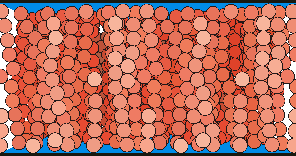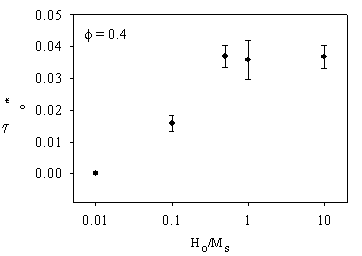The main goal of particle-level simulations is to determine macroscopic properties of MR and ER suspensions using information from the particle length scale, such as the particle size, interactions, etc. The method involves integrating the equation of motion for each particle,
subject to the force Fi acting on each particle. Force we typically consider include the magnetostatic or electrostatic interparticle forces induced by the external field, hydrodynamic drag forces, and short-range repulsive forces that keep particles from overlapping.
Numerical integration of the equations of motion provides the positions of all particles as a function of time, from which we can evaluate macroscopic properties. For example, the shear stress, and hence various rheological properties, can be evaluated via
where Fxi is the x-component of the non-hydrodynamic force on particle i.
These simulations can be used to probe a variety of features of MR and ER suspensions. Below we show a few examples.
Structure Formation
Application of an external field to a suspension is known experimentally to induce the formation of particulate columns. In Figure 1 below, we show a structure predicted from the simulations. Clearly, fibrous aggregates are observed, similar to what is seen experimentally. We have also shown that the time required for structures to form compares well with experiments (1-100 ms for concentrated suspensions).
Rheological Properties
In Figure 2 below, we show a plot of the simulated yield stress of a 40 vol% suspension of iron spheres. The yield stress initially increases with magnetic field strengths, and then saturates at large field strengths. This behavior is commonly seen experimentally.
We are currently exploiting these simulations to design improved fluids containing mixtures of different types of spheres.



